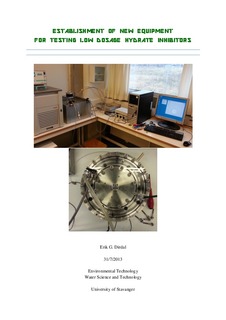| dc.description.abstract | Gas hydrate formation posses a notorious concern for the oil and gas industry, and it only gets bigger because of that the never-ending pursuit of oil and gas compels the industry into deeper and colder waters. Here gas hydrate can from and agglomerate into plugs, jeopardizing pipelines and process equipments. Therefore a variety of methods have been developed to inhibit gas hydrate formation, one of them being to utilize low dosage hydrate inhibitors, which consists of kinetic hydrate inhibitors and anti-agglomerants. Low dosage hydrate inhibitors are relatively expensive, and it is therefore important to determine effective concentrations in laboratory apparatuses. Test apparatuses and methods are numerous, and the majority are THF rigs, rocker rigs, autoclaves, pipe wheels and flow loops. Prior methods for assessing hydrate inhibitors performance concentration tend to suffer form not being repeatable in addition to be inconsistent. Thus there are always possible for new hydrate inhibition test methods and apparatuses.
A prototype table top wheel was developed for testing low dosage hydrate inhibitors. It consisted of a wheel submerged in a water bath. Unique features of the table top wheel was its small size, the acrylic top disk and the mode of moving the liquid in the apparatus. A swirling circular motion made the liquid move based on the "Euler disk" mechanical movement, hence no pumps or internal equipment for propelling the liquid was utilized.
Preliminary tests were conducted to approve the apparatus for future experimental work, by providing a gas hydrate formation method of a consistent manner. The result for the same anti-agglomerant range in both 1.5wt% NaCl solution and distilled water, obtained in the table top wheel was compared to the rocker rig RCS20. This was done to confirm if this apparatus indeed could be used to rank inhibitors, thus a validation of the apparatus.
It was confirmed that the table top wheel result for the same anti-agglomerant range in both 1.5wt% NaCl solution and distilled water had the same trend as the results from the rocker rig. The table top wheel was thereby validated and approved at least for this anti-agglomerant range. However, the concentration required for an adequate inhibition was higher in the table top wheel compared to the rocker rig, hence the table top wheel was a more conservative test apparatus than the rocker rig.
Unfortunately the table top wheel could not be operated safely after 59 pressurized experiments, due to cracks in the acrylic top disk. This was a severely design flaws which must be sorted out for the apparatus to progress.
However, as far as being a prototype the table top wheel approved to be adequate. It yielded reliable and predictable test results and provided a consistent method for both hydrate formation and inhibitor testing. | no_NO |
